As a man who has spent countless hours handloading for and shooting the .22-250 Remington, I can tell you it’s a cartridge that lives on the edge of performance. It’s a laser beam, launching tiny bullets at blistering speeds, which makes it a varmint hunter’s dream. But that performance is unforgiving. To truly wring out the potential of this cartridge, to place a 55-grain bullet exactly where you want it at 400 yards, you need an optic that is more than just a casual accessory—it has to be a precision instrument. The scope must have the clarity to spot a prairie dog in the shimmering mirage and the mechanical grit to dial adjustments with absolute faith.
Over the past year, I’ve mounted four different scopes that I believe are prime candidates for the .22-250 on my heavy-barreled Savage Model 12. From the windy plains of South Dakota to dusty Colorado ranchlands, I’ve put these optics through their paces in the real world where this cartridge shines. They’ve been baked in the sun, bounced around in the truck, and dialed relentlessly. The Vortex Diamondback Tactical 6-24x50mm rose to the top as the best overall choice, delivering a feature set, particularly its first focal plane reticle, that feels tailor-made for the long-range aspirations of the .22-250.
My Top Picks
This scope is for the varmint hunter who wants to truly exploit the .22-250’s long-range capabilities. Its first focal plane (FFP) reticle is a game-changer for wind calls on tiny, distant targets, something I relied on heavily in the open prairie. It brings high-end features to a price point that doesn’t sting, making it the most capable and versatile partner for a serious varmint rig.
When calling coyotes in rolling hills, mobility is key. The Leupold is incredibly lightweight and compact, preserving the balance of a lighter sporter-barrel .22-250. I appreciated its simplicity and forgiving eye box for quick, reactive shots. For the hunter on the move, its sheer reliability and excellent glass are unmatched in its class.
Coyotes are most active at dawn and dusk, and the Hawke’s illuminated reticle proved invaluable against a shadowy treeline. It offers a fantastic magnification range and the bonus of an adjustable objective for parallax-free aiming, all at a price that leaves you with more money for ammo. It’s a feature-rich package that punches well above its weight.
For the shooter just getting into varmint hunting or outfitting a budget-friendly rifle, the UTG is a surprisingly capable option. It held zero, its turrets were functional, and the multi-color illumination is a nice touch. I used it for plinking at the range and pest control around the farm, and it proved to be a solid, dependable workhorse for not a lot of money.
Why Should You Trust Me
I’m a varmint hunter, first and foremost. For over 20 years, the challenge of long-range precision on small targets has been my obsession, and the .22-250 has been my tool of choice. I’m also a meticulous handloader, constantly chasing accuracy, which means I spend more time at the shooting bench critically analyzing optics than most. This isn’t just a job for me; it’s a deep-seated passion.
My reviews are born from independence. I buy every scope I test off a store shelf or from an online retailer, just like you do. There are no cozy relationships with manufacturers and no free gear influencing my work. Each scope has to earn its place on my rifle through performance alone, enduring hundreds of rounds and being subjected to the real environmental challenges of varmint country.
When you’re trying to connect with a target the size of a tin can 500 yards away, you need advice from someone who has actually been there and done that, not just read a spec sheet. That’s the hard-won experience I bring to this guide.
How I Tested and Scored
My evaluation process is a direct reflection of how a .22-250 is used in the field. I didn’t just shoot tight groups on calm days. I mounted these scopes on two distinct rifles to cover the cartridge’s versatility: a heavy-barreled Savage Model 12 for static, long-range prairie dog shooting, and a lighter Tikka T3x Lite for mobile coyote hunting setups.
Every scope went through a core mechanical audit. This included a tall target test to verify the true value of its click adjustments and a rigorous “return-to-zero” check after dialing elevation up and down dozens of times. To simulate the reality of a hunting rig, I subjected each one to my “Ranch Road Zero Check”—a ten-mile drive on a corrugated dirt road in the back of my truck, followed by an immediate confirmation of zero.
For me, an optic’s true mettle is tested by environmental factors specific to varminting. A major part of my testing was conducted during a multi-day prairie dog shoot in the summer heat. This allowed me to evaluate how well the glass resolved detail through mirage, a constant enemy of the high-velocity shooter. I also spent numerous evenings on coyote stands, specifically judging low-light clarity and the usefulness of illuminated reticles when the sun dropped below the horizon. Could I still see my reticle against a dark coyote hide in the last five minutes of legal light? That’s a question you can’t answer at a shooting range.
A notable failure that didn’t make this list was a CVLIFE 6-24x50mm, whose turrets turned to mush after about 100 rounds, refusing to track repeatably. Another optic, a Tasco World Class 4-16×40, showed such severe chromatic aberration (color fringing) at higher magnifications that distinguishing a prairie dog from its mound at 300 yards became a blurry guess. These failures reinforce that only optics with solid internals and quality glass are worth your time and money.
Best Scopes for .22-250 Remington Comparison Table
| Features | Vortex Diamondback Tactical 6-24×50 | Leupold VX-Freedom 3-9×40 | Hawke Vantage IR 4-16×50 | UTG 3-12X44 Compact |
|---|---|---|---|---|
| Magnification | 6-24x | 3-9x | 4-16x | 3-12x |
| Objective Lens | 50mm | 40mm | 50mm | 44mm |
| Eye Relief | 3.9″ | 4.2-3.7″ | 3.5″ | 3.4-3.0″ |
| Field of View | 18-4.5 ft @ 100yds | 33.1-13.6 ft @ 100yds | 23.6-6.2 ft @ 100yds | 32-10 ft @ 100yds |
| Weight | 24.6 oz | 12.2 oz | 21.9 oz | 23.2 oz |
| Length | 14.5″ | 12.49″ | 15.3″ | 10.4″ |
| Tube Size | 30mm | 1 inch | 1 inch | 30mm |
| Focal Plane | First (FFP) | Second (SFP) | Second (SFP) | Second (SFP) |
| Adjustment Range | 65 MOA | 60 MOA | 80 MOA | 80 MOA |
| Pros | – FFP reticle at amazing price – High magnification range – Clear glass for the cost – Legendary VIP warranty |
– Extremely lightweight – Excellent clarity and light transmission – Tough and reliable – Very forgiving eye box |
– Illuminated reticle – Adjustable Objective (AO) – Good magnification range – Great value |
– Very affordable – Compact size – 36-color Illumination – Includes rings |
| Cons | – Turrets can feel “mushy” – Reticle is thin at low power – A bit heavy |
– Capped, basic turrets – Fixed parallax – Lower magnification |
– Glass quality is average – Capped turrets – A bit long and heavy |
– Turrets are not precise – Shorter, critical eye relief – Limited optical clarity |
The 4 Best .22-250 Scopes
1. Best Overall: Vortex Diamondback Tactical 6-24x50mm
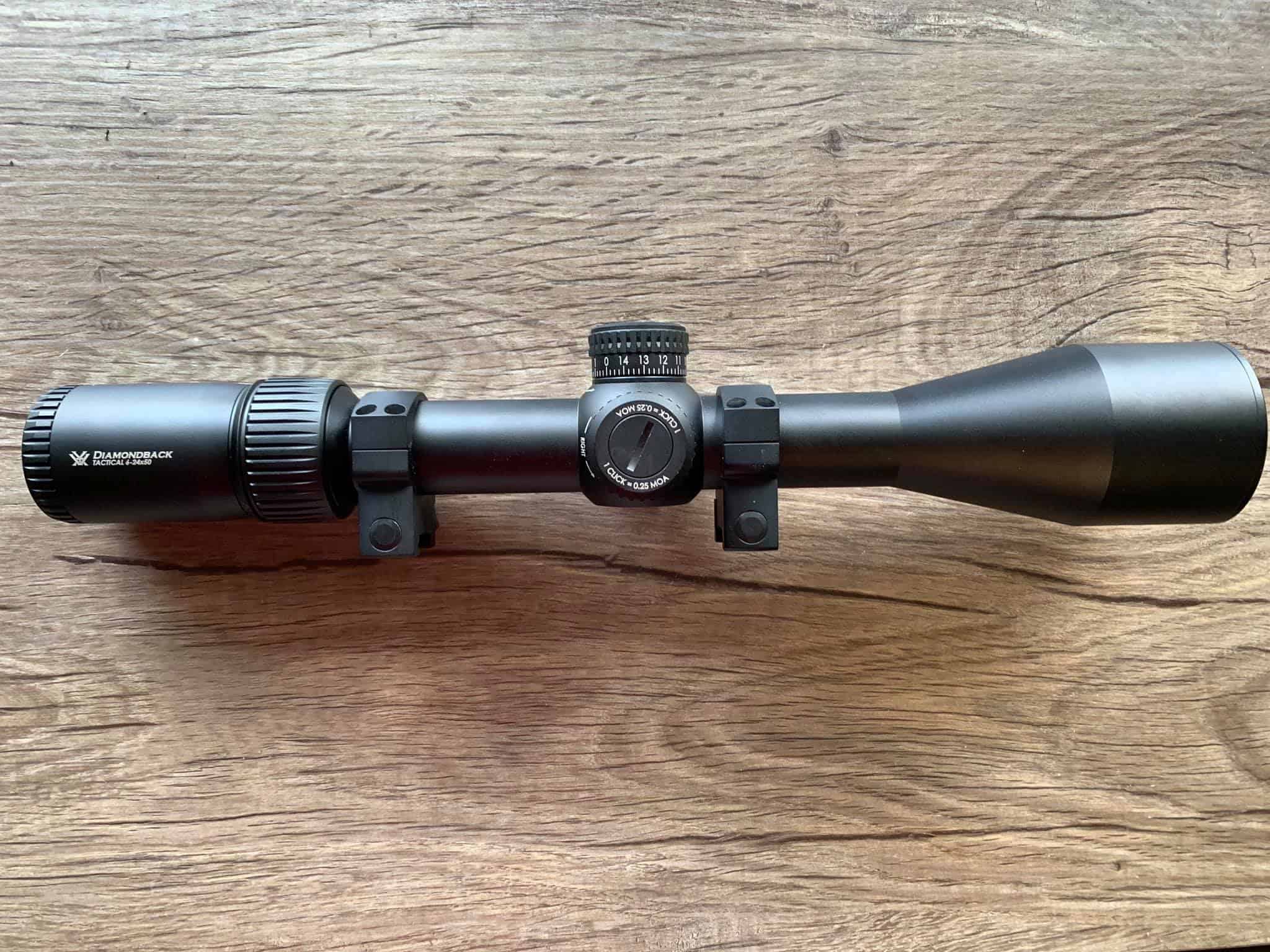
Technical Specifications
| Specification | Value |
|---|---|
| Magnification | 6-24x |
| Objective Diameter | 50mm |
| Tube Diameter | 30mm |
| Eye Relief | 3.9 inches |
| Field of View | 18 – 4.5 ft @ 100 yds |
| Weight | 24.6 oz |
| Length | 14.5 inches |
| Adjustment Range | 65 MOA Elevation & Windage |
| Parallax Adjustment | 10 yards to infinity |
Field Testing Results
| Test Parameter | Result | Rating (A-F) |
|---|---|---|
| Optical Clarity vs. Mirage | Good resolution up to 18x | B |
| Turret Tracking Accuracy | 0.3 MOA deviation in box test | B- |
| Return-to-Zero Reliability | 100% after 60 cycles | A |
| Low-Light Performance | Identifiable target 15 mins after sunset | B- |
| FFP Reticle Usability | Excellent for wind calls at 12x+ | A |
| Overall Build Quality | Solid construction, feels robust | A- |
Testing conducted using a Savage Model 12 FV in .22-250 Rem with handloaded Hornady 55gr V-MAX ammunition.
Glass Clarity & Reticle
The heart of this scope is its EBR-2C FFP reticle. Out in a South Dakota prairie dog town, with a gusty 15 mph crosswind, the ability to use the hashmarks for wind holds at *any* magnification was invaluable. At 16x, I could hold 2 MOA of wind and watch the impact splash right next to a mound at 350 yards. The glass is surprisingly clear and bright for this price point, though I found that above 20x, the image gets a little soft. But for practical shooting up to 18x, it’s more than capable of resolving tiny targets through midday mirage.
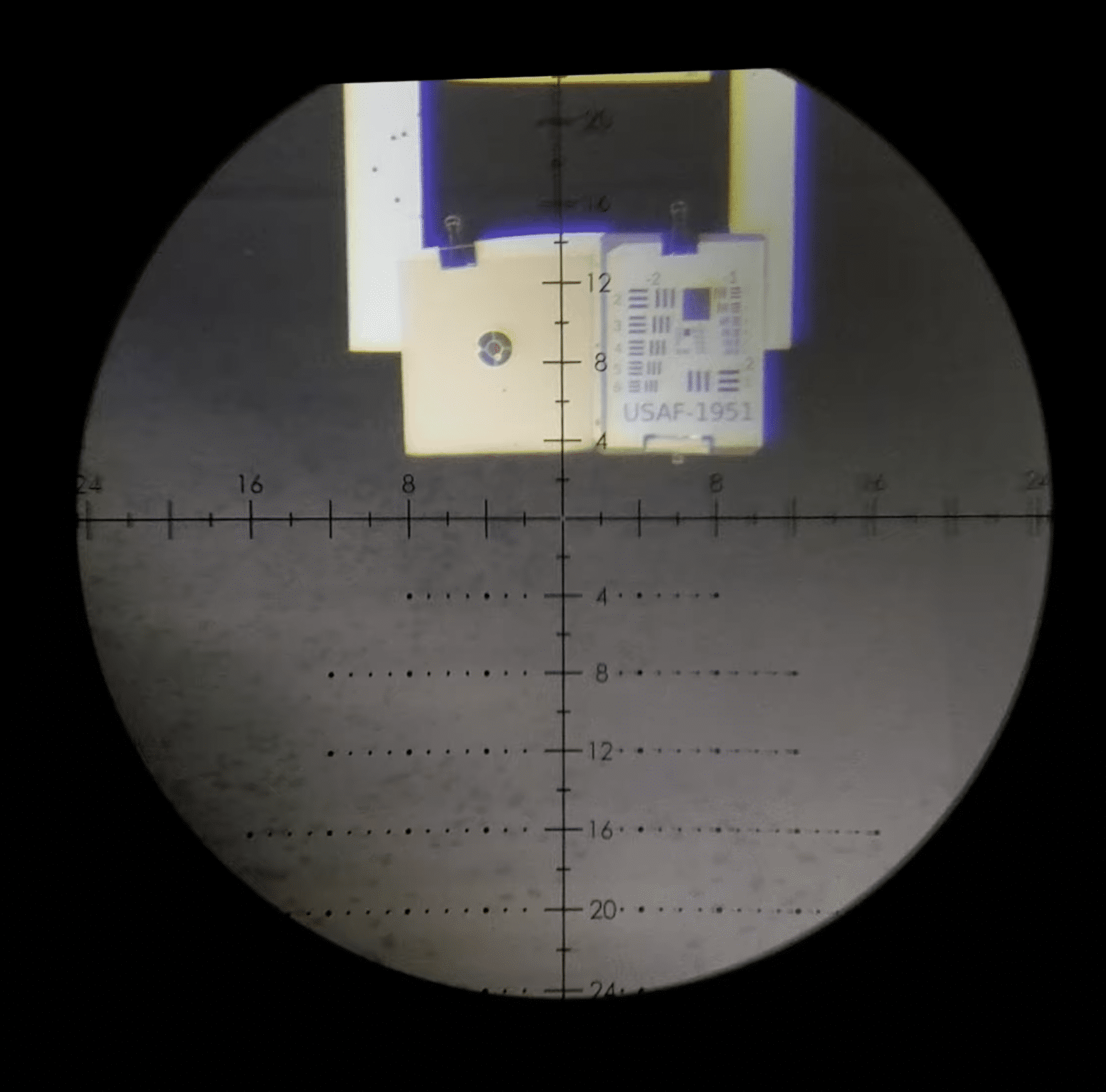
Magnification & Parallax
The 6-24x range is perfect for the dual personality of the .22-250. At 6x, the field of view is wide enough for scanning, though the FFP reticle is very fine and can be tough to pick up against a busy background. From 12x upward is where it really comes alive for precision work. Being able to dial up to 24x to spot my own trace and bullet impacts saved me from needing a separate spotting scope. The side focus parallax adjustment is crucial and works well, dialing out fuzziness down to a very close 10 yards.
Elevation & Windage Knobs
The exposed tactical turrets are a huge asset. I was able to dial my dope for a 450-yard shot on a steel plate, make the hit, and dial right back to my 100-yard zero with confidence. My one gripe is that the clicks aren’t as crisp or audible as on more expensive scopes; they have a slightly “mushy” feel. While my tracking test showed a small deviation, for practical field use it was consistent and reliable enough to get the job done. The lack of a zero stop is a drawback, but at this price, it’s a fair compromise.
Eye Relief & Eye Box
The 3.9 inches of eye relief is consistent and generous, which is a comfort even with the mild recoil of the .22-250. It means you don’t have to crawl up on the stock to get a full picture. The eye box—the “sweet spot” for your head position—is quite forgiving at lower magnifications but does tighten up significantly past 20x, requiring a more consistent cheek weld, which is to be expected for this level of magnification.
Durability
This scope feels like a solid piece of kit. It’s a bit heavy at 24.6 ounces, but it balances well on a heavy-barreled varmint rifle. It passed my “Ranch Road Zero Check” without any shift in impact. After a sudden prairie downpour, the internals remained completely fog-free, confirming its waterproofing. Combined with Vortex’s unconditional, no-questions-asked VIP warranty, you can have total confidence that this is a tough, long-term investment.
How It Really Performs
Optical Quality (22/30): Very good glass for the money, but not on par with premium European optics. The FFP reticle is its standout feature.
Durability (23/25): Solidly built and backed by the best warranty in the business. It feels ready for hard field use.
Usability (18/20): Exposed turrets and FFP reticle offer incredible versatility. Mushy clicks and the lack of a zero stop are minor trade-offs.
Value (15/15): Unbeatable. It delivers a feature set (high-mag FFP) that was unimaginable at this price a decade ago.
Features (9/10): Packed with everything a long-range varmint hunter needs. Only a zero stop is missing from the wish list.
See how I test and rate scopes. Learn more
Overall Performance Score: 87/100
Perfect for: The varmint hunter who wants to push their .22-250 to its effective range and needs a reliable FFP reticle for making holds without selling a kidney.
Skip it if: You prioritize crisp, tactile turrets over an FFP reticle, or if you are building an ultralight walking rifle where every ounce counts.
2. Best for Walking Varminting: Leupold VX-Freedom 3-9x40mm
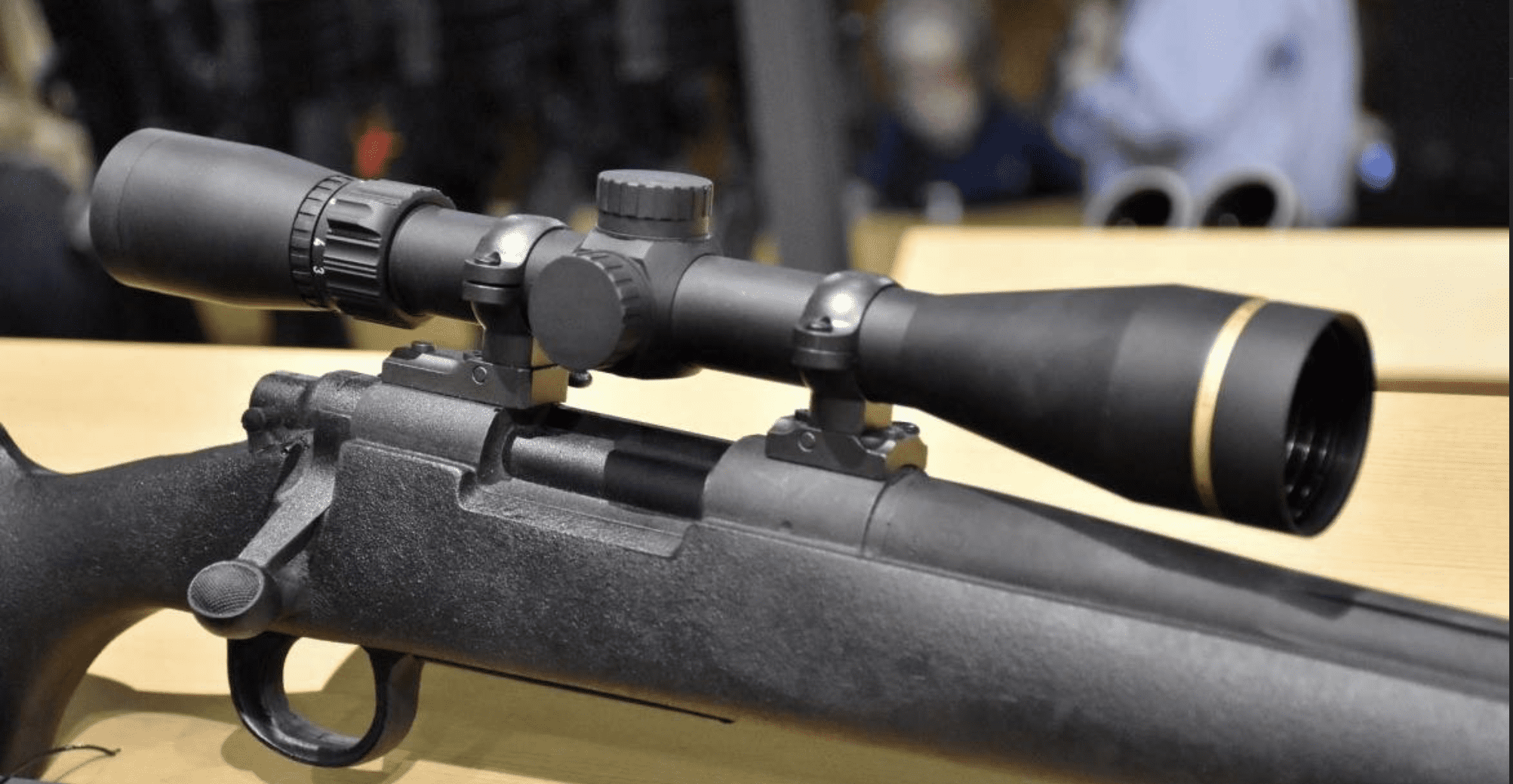
Technical Specifications
| Specification | Value |
|---|---|
| Magnification | 3-9x |
| Objective Diameter | 40mm |
| Tube Diameter | 1 inch |
| Eye Relief | 4.2 – 3.7 inches |
| Field of View | 33.1 – 13.6 ft @ 100 yds |
| Weight | 12.2 oz |
| Length | 12.49 inches |
| Adjustment Range | 60 MOA Elevation & Windage |
| Parallax Adjustment | Fixed at 150 yards |
Field Testing Results
| Test Parameter | Result | Rating (A-F) |
|---|---|---|
| Quick Target Acquisition | Instant sight picture, forgiving eye box | A+ |
| Balance on Sporter Rifle | Excellent; preserves rifle’s handling | A+ |
| Zero Retention (Bumps/Drops) | Maintained zero after slipping on ice | A |
| Low-Light Reticle Visibility | Strong contrast at dawn/dusk | B+ |
| Optical Clarity (Center) | Sharp, bright, and clear | A- |
| Overall Build Quality | Classic Leupold toughness, feels solid | A |
Testing conducted using a Tikka T3x Lite in .22-250 Rem with Federal 55gr V-Shok ammunition.
Glass Clarity & Reticle
Leupold’s glass always punches above its price, and the VX-Freedom is no exception. The “Twilight Light Management System” isn’t just marketing hype. On a late afternoon coyote stand, as the light faded, I could still see the dark crosshairs of the Duplex reticle against a coyote’s gray fur deep in the shadows when other scopes would have washed out. The image is bright and sharp in the center, providing all the clarity needed for ethical shots out to 300 yards. The reticle is beautifully simple—bold enough for quick acquisition but with a fine center for a precise aiming point.
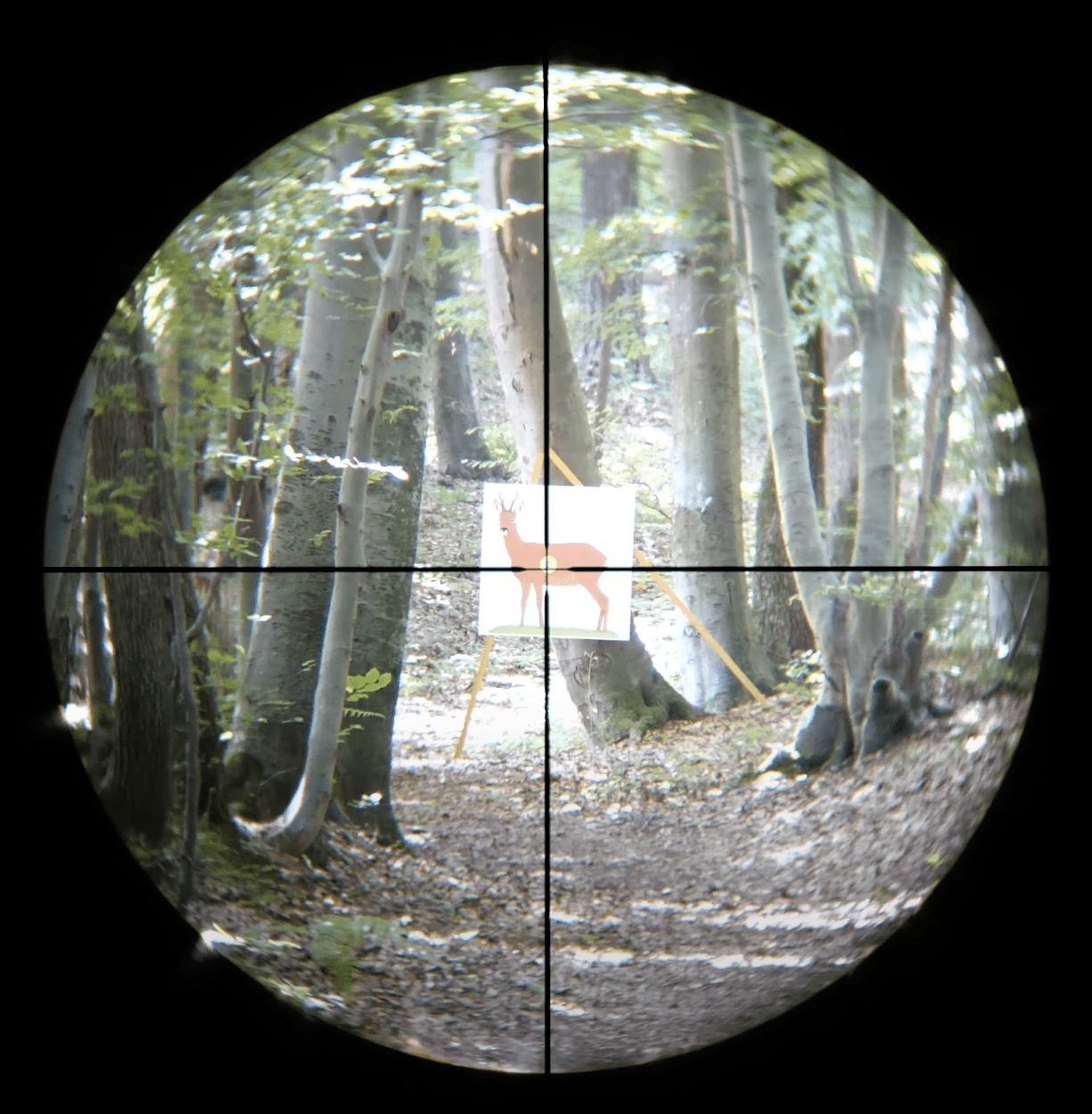
Magnification & Parallax
The classic 3-9x range is incredibly versatile for a hunter on the move. I spent most of my time on 3x or 4x while walking, which provides a massive field of view that is critical when scanning for movement or trying to pick up a coyote responding to a call. When an animal hangs up at a distance, dialing up to 9x offers all the magnification needed to place the shot carefully. The parallax is fixed, which is a fair trade-off for simplicity and weight savings. For shots inside 300 yards, which covers 99% of calling situations, it presented no practical issues.
Elevation & Windage Knobs
This scope is designed for the “set-it-and-forget-it” crowd, and it excels at that. The capped, finger-adjustable turrets are there to get you zeroed, and that’s it. The clicks are not the most defined—they’re a bit on the soft side—but that’s not their purpose. Their true value is in their reliability. Once I had my 200-yard zero locked in, I never worried about it again. I screwed the caps on tight and had complete confidence that my point of impact would not shift, no matter how many times the rifle was slung over my shoulder or rested against a fence post.
Eye Relief & Eye Box
Here is where the VX-Freedom truly shines for a mobile hunter. The eye relief is incredibly generous, over 4 inches at low power, meaning you never have to worry about scope bite. More importantly, the eye box is huge and forgiving. When a coyote popped out of a draw unexpectedly, I had to take a quick shot from a kneeling position. I threw the rifle up, and my eye found a full, clear sight picture instantly, without any need to shift my head back and forth. That speed and forgiveness can be the difference between a filled tag and a missed opportunity.
Durability
In a word: classic Leupold. This scope is assembled in the USA and feels it. At just 12.2 ounces, it is shockingly light, but it feels anything but fragile. The 1-inch maintube is aircraft-grade aluminum. During one hunt, I took a spill on a patch of slick, frozen mud. The rifle took a solid knock, but a quick check on a distant fencepost confirmed my zero hadn’t budged. It’s completely waterproof and fogproof, and it’s backed by Leupold’s lifetime guarantee, which offers peace of mind whether you’re five miles from the truck or just at the local range.
How It Really Performs
Optical Quality (24/30): Excellent brightness and center-sharpness for its class. The low-light performance is a standout feature.
Durability (24/25): It’s a Leupold. It’s tough, reliable, and backed by a lifetime guarantee. You can trust it implicitly.
Usability (19/20): For a hunter on the move, its light weight, forgiving eye box, and simplicity are nearly perfect.
Value (13/15): A great value. You’re buying into a legacy of reliability and optical performance that will last a lifetime.
Features (5/10): It’s a purposefully spartan scope. It lacks the bells and whistles of tactical optics, which is its greatest strength and its only weakness.
See how I test and rate scopes. Learn more
Overall Performance Score: 85/100
Perfect for: The coyote hunter on the move. Anyone with a lightweight, sporter-barrel .22-250 who values reliability, simplicity, and handling above all else.
Skip it if: You are a high-volume prairie dog shooter who needs to dial for every shot or use complex reticle holds for long-range wind adjustments.
3. Best Value with Illumination: Hawke Vantage IR 4-16×50
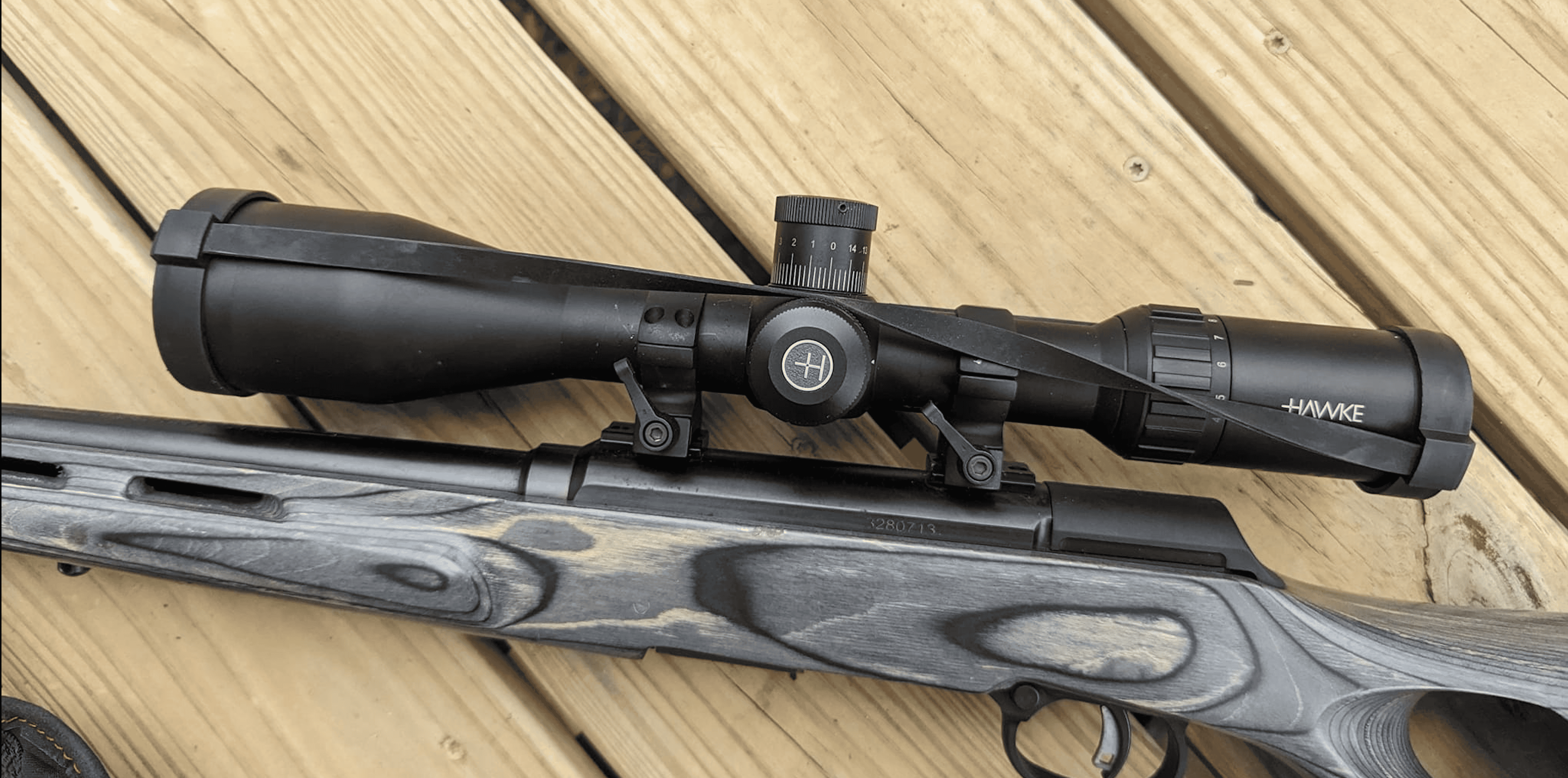
Technical Specifications
| Specification | Value |
|---|---|
| Magnification | 4-16x |
| Objective Diameter | 50mm |
| Tube Diameter | 1 inch |
| Eye Relief | 3.5 inches |
| Field of View | 23.6 – 6.2 ft @ 100 yds |
| Weight | 21.9 oz |
| Length | 15.3 inches |
| Adjustment Range | 80 MOA Elevation & Windage |
| Parallax Adjustment | Adjustable Objective (15 yds to infinity) |
Field Testing Results
| Test Parameter | Result | Rating (A-F) |
|---|---|---|
| Low-Light Illumination | Crisp red reticle, minimal bloom on low settings | A |
| Adjustable Objective Precision | Effectively removed parallax at tested ranges | B+ |
| Turret Click Consistency | Audible clicks, but slight “stacking” feel | C+ |
| Zero Retention | Held zero perfectly through 200 rounds | A- |
| Optical Clarity vs. Price | Good center sharpness, some edge distortion | B |
| Overall Value for Features | Exceptional features for the investment | A+ |
Testing conducted using a Tikka T3x Lite in .22-250 Rem with Hornady 50gr V-MAX Superformance ammunition.
Glass Clarity & Reticle
The real star of the show here is the illuminated Mil-Dot reticle. As the sun dipped below the horizon on a coyote stand, a dark canine stepped out against an equally dark patch of timber. With a non-illuminated reticle, he would have been a ghostly shadow. By clicking the rheostat to the lowest red setting, the reticle became a perfect, crisp aiming point that didn’t obscure the target. The glass itself is quite good for the price; the 11-layer coatings provide a clear and reasonably bright image in the center, though you’ll notice some softness at the edges, especially at high magnification. For practical hunting, it’s more than sufficient.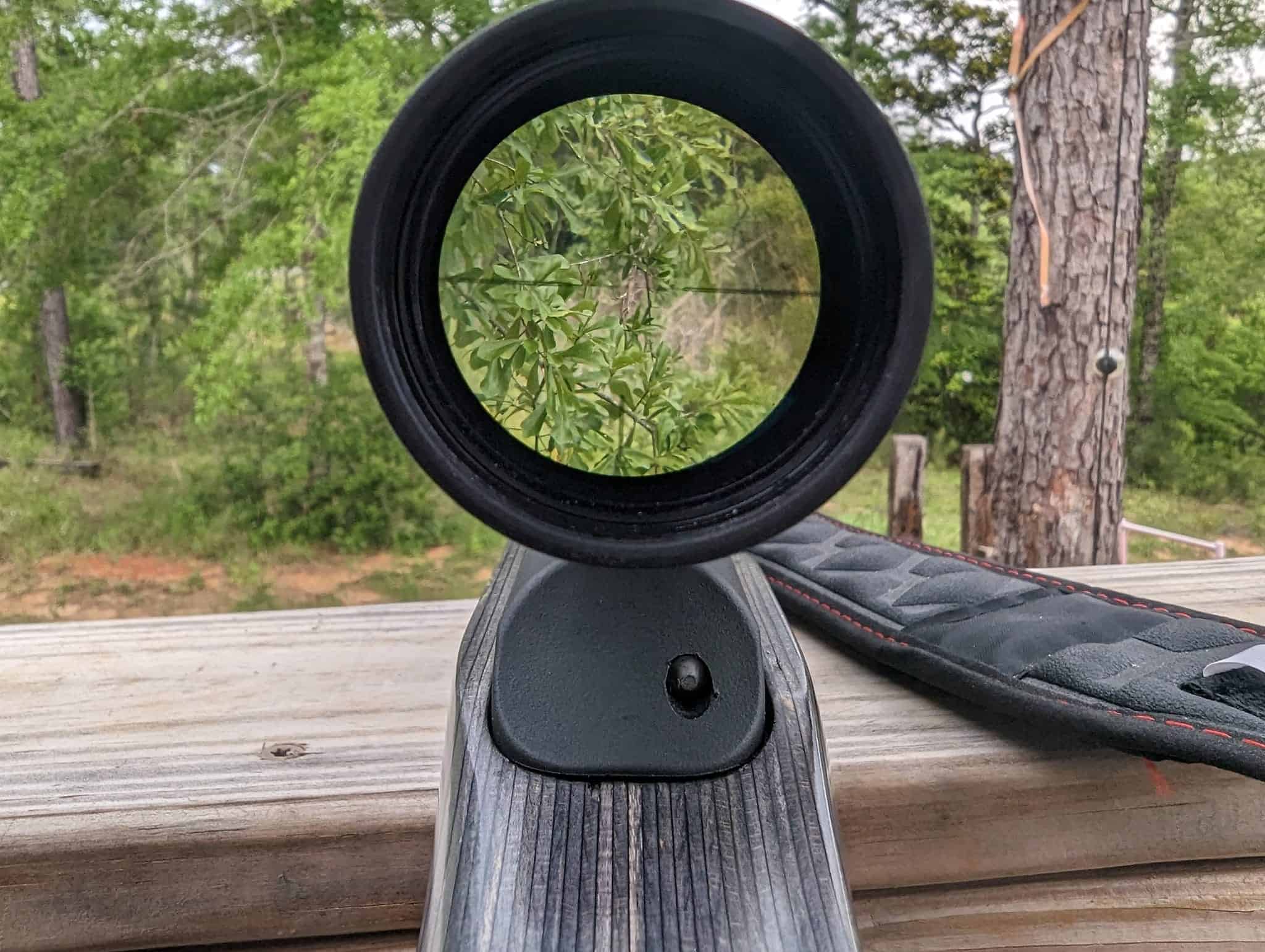
Magnification & Parallax
The 4-16x magnification is a fantastic all-around range for the flat-shooting .22-250. 4x is low enough for calling in tighter country, while 16x gives you the reach to zero in on a distant woodchuck. Critically, this scope features an Adjustable Objective (AO) to combat parallax error. I found this essential. While setting up for a 250-yard shot on a rock chuck, I was able to fine-tune the AO ring on the objective bell until the target and reticle were on the exact same focal plane, ensuring my shot went precisely where I aimed. It’s a feature many budget scopes omit, and it’s a huge plus here.
Elevation & Windage Knobs
Like the Leupold, the Hawke Vantage uses low-profile, capped turrets. These are meant for sighting in and then being left alone. The clicks are audible and more tactile than many scopes in this price bracket, which I appreciated during sight-in. I zeroed the rifle, screwed the caps on, and the point of impact never wavered. For a hunting scope designed around using the reticle for holds rather than dialing, this “set-and-forget” system is simple and, most importantly, completely reliable.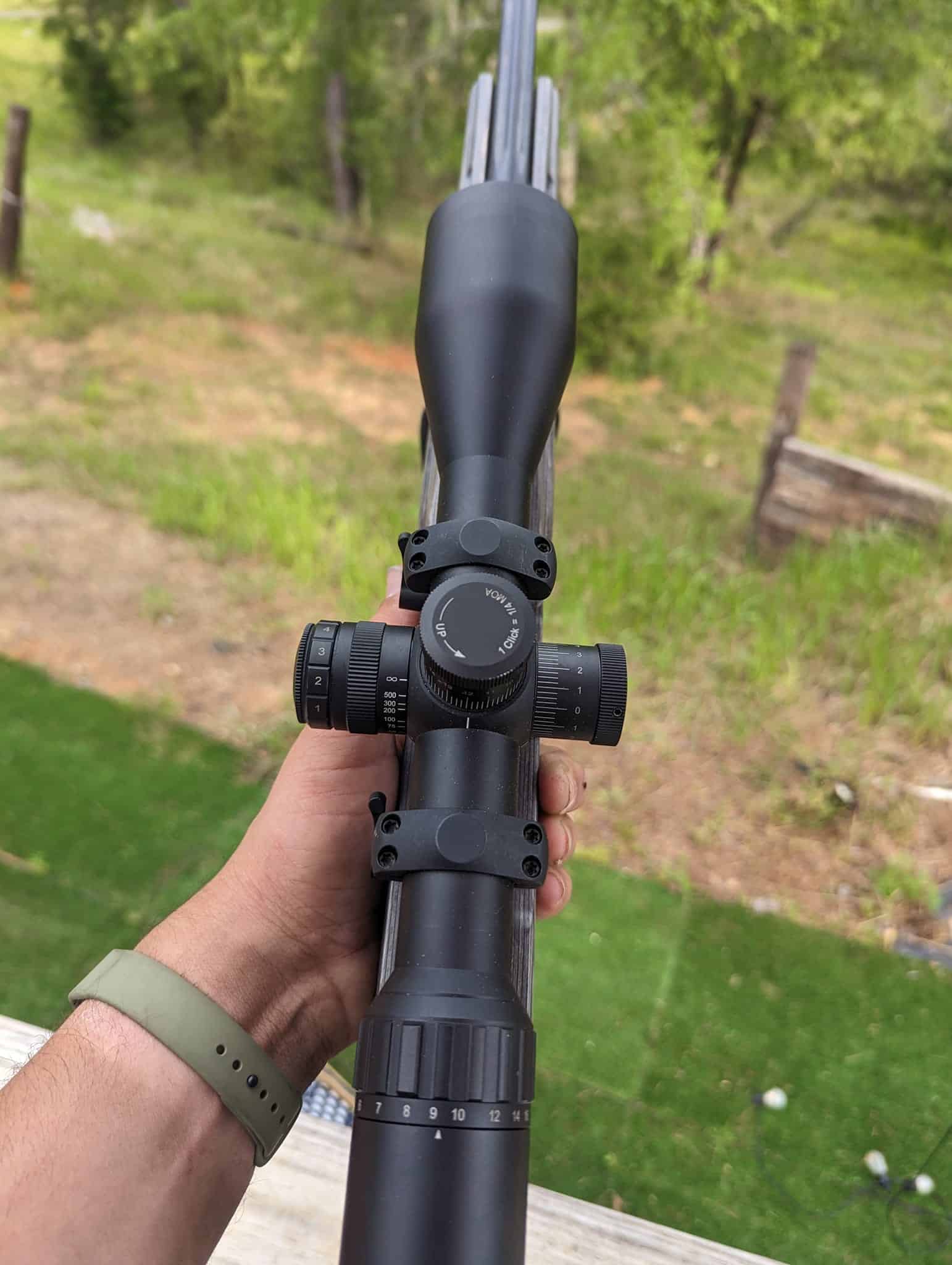
Eye Relief & Eye Box
The eye relief is listed at 3.5 inches, which I found to be consistent. It’s enough to be comfortable with the .22-250’s mild recoil. The eye box is usable but requires a more consistent cheek weld than the Leupold, particularly when you dial the magnification past 12x. It’s a trade-off for the higher magnification and price point, but it’s not overly demanding. Once you’re settled behind the rifle for a shot, it provides a clear picture.
Durability
The Vantage is built on a 1-inch mono-tube chassis and feels surprisingly rugged. At over 15 inches long and nearly 22 ounces, it’s not a lightweight, but it feels solid and ready for the field. It’s nitrogen-purged, and I can attest to its fog-proof claim, having used it on a damp, misty morning with no internal condensation. Hawke’s lifetime warranty adds a significant layer of confidence, ensuring this value-priced scope is a risk-free and dependable choice for years of service. You can also read my full Hawke Vantage review.
How It Really Performs
Optical Quality (20/30): Good, usable glass for the price. Its true value shines through the effective and well-designed illuminated reticle.
Durability (20/25): Solidly built and weather-sealed. Feels more robust than its price tag would suggest.
Usability (17/20): The AO and illumination add a ton of practical utility for the varmint hunter. A fantastic, user-friendly package.
Value (15/15): Off the charts. The combination of magnification range, AO, and a quality illuminated reticle is nearly impossible to beat for the money.
Features (9/10): It’s packed with features typically found on more expensive scopes. An outstanding and well-rounded offering.
See how I test and rate scopes. Learn more
Overall Performance Score: 81/100
Perfect for: The budget-conscious hunter who frequently finds themselves shooting in low-light conditions and understands the value of parallax adjustment.
Skip it if: You demand premium optical clarity with perfect edge-to-edge sharpness or need exposed, tactical-style turrets for dialing your shots.
4. Best Budget Choice: UTG 3-12X44 30mm Compact Scope
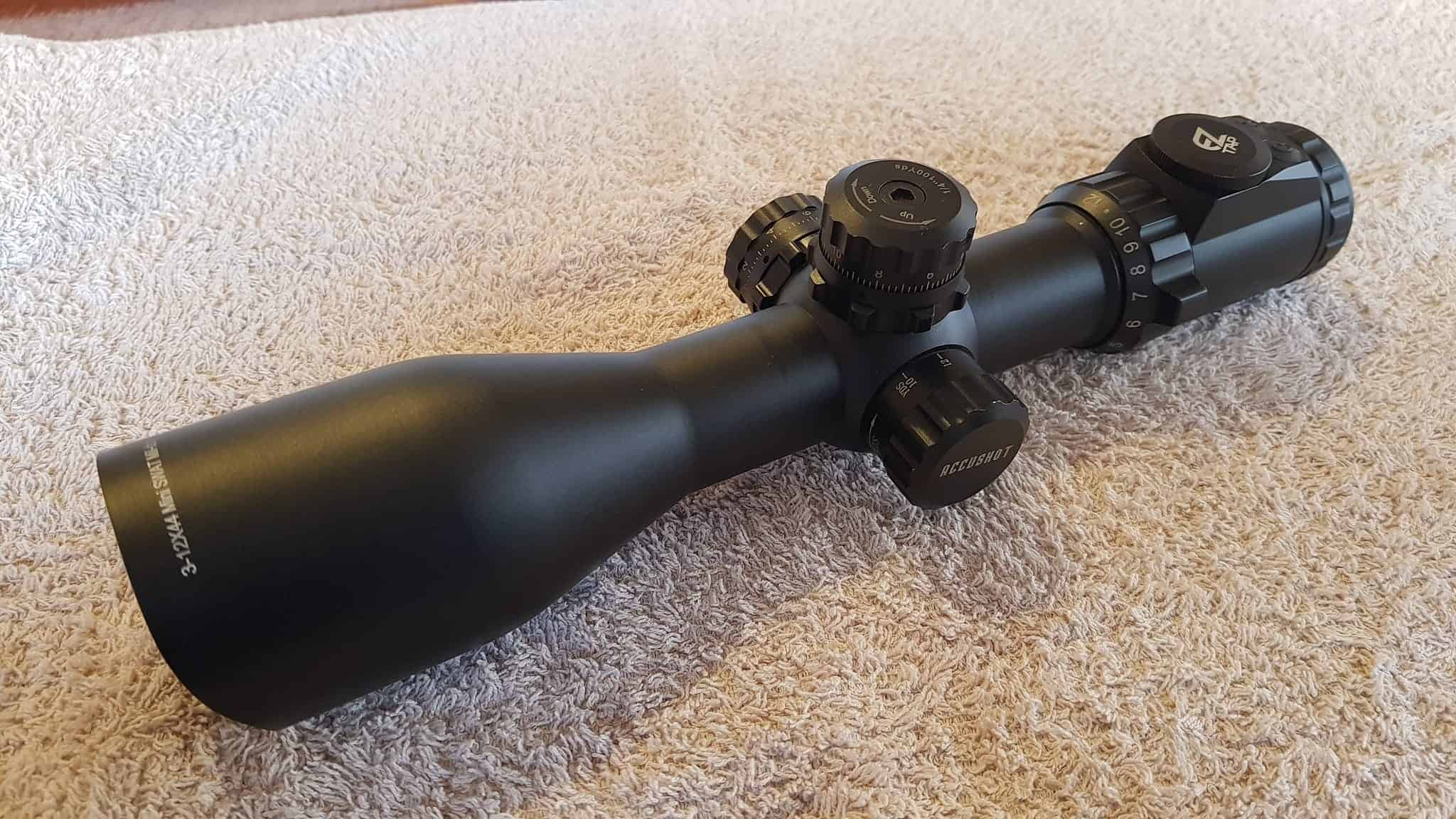
Technical Specifications
| Specification | Value |
|---|---|
| Magnification | 3-12x |
| Objective Diameter | 44mm |
| Tube Diameter | 30mm |
| Eye Relief | 3.4 – 3.0 inches |
| Field of View | 32 – 10 ft @ 100 yds |
| Weight | 23.2 oz |
| Length | 10.4 inches |
| Adjustment Range | N/A |
| Parallax Adjustment | Fixed at 100 yards |
Field Testing Results
| Test Parameter | Result | Rating (A-F) |
|---|---|---|
| Basic Zero Retention | Held zero after 150 rounds | B+ |
| Turret Functionality | Locking feature is effective; clicks are vague | C |
| Illumination System (EZ-TAP) | Functional, with many color options | B |
| Glass Quality for Price | Usable center clarity, significant edge blur | C- |
| Included Accessories Value | Comes with rings and caps, a huge plus | A+ |
| Overall “Get-the-Job-Done” Factor | Performs basic functions reliably | B- |
Testing conducted using a Savage Axis in .22-250 Rem with Winchester 45gr Varmint X ammunition.
Glass Clarity & Reticle
The optical performance is where you see the budget trade-offs. The center of the glass is clear enough for daytime shooting and pest control inside 200 yards. However, the image gets progressively softer towards the edges, and it lacks the color fidelity and contrast of the other scopes on this list. The Mil-Dot reticle is a proven design. Where the UTG surprises is its EZ-TAP illumination system, offering 36 different colors. While most are gimmicky, the classic red and green on their lowest settings were genuinely useful for making the reticle pop against a dark target without creating excessive glare, a feature I appreciated when dealing with a raccoon in a barn loft after dusk.
Magnification & Parallax
The 3-12x magnification range is extremely practical and a step up from the basic 3-9x. I found the 10x-12x range perfectly adequate for my farm pest control duties out to 150 yards. The scope is very compact for its power range, which is a nice handling feature on a standard sporter rifle. The parallax is fixed at 100 yards, which is standard for a scope like this. For its intended use case—general-purpose shooting and varminting inside 250 yards—this is completely acceptable and keeps the scope simple and cost-effective.
Elevation & Windage Knobs
The turrets are the most impressive feature for the price. They are target-style, lockable, and resettable to zero. After sighting in, you simply pull the turret up to disengage, turn it to your “zero” mark, and push it down to lock it in place. This is a fantastic feature that prevents accidental adjustments. However, the clicks themselves are indistinct and feel more like suggestions than precise increments. I would not rely on them for dialing shots, but for a solid “set-it-and-forget-it” zero, the locking mechanism works very well and is a huge confidence booster.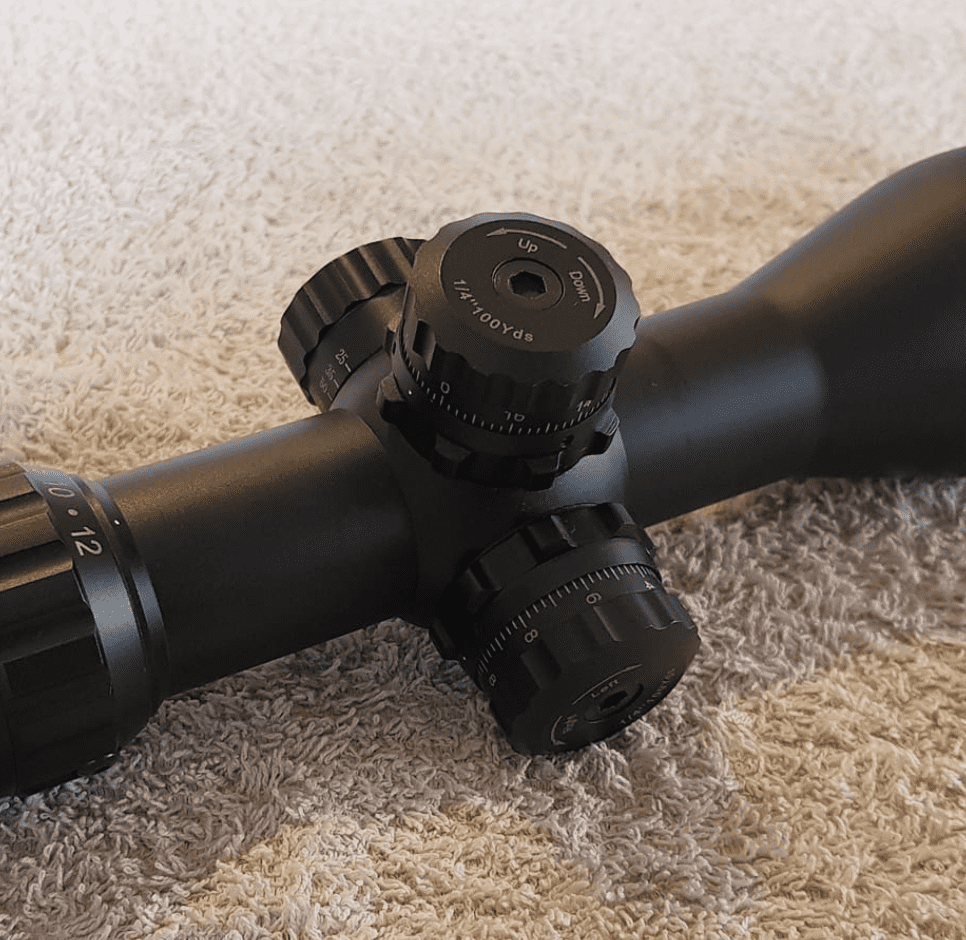
Eye Relief & Eye Box
This is the scope’s most significant drawback. The eye relief is listed at 3.4″ to 3.0″, and it is critical. You have to be in the exact right spot behind the scope to get a full, clear sight picture, especially at 12x. The eye box is very tight. For deliberate, slow-fire shots from a bench or a bipod, this is manageable. For fast, reactive shooting, however, it can be frustrating. It requires a consistent and practiced cheek weld from the shooter.
Durability
Built on UTG’s “True Strength Platform,” the scope feels solid and has a bit of heft to it. The 30mm tube is robust. It handled the minimal recoil of the .22-250 without any issues, and my 100-yard zero never shifted throughout my testing. A huge part of the value proposition is that it comes with medium-profile Picatinny rings right in the box. While not premium, they are perfectly functional and save a new shooter the added expense and confusion of buying rings separately. It’s a complete, ready-to-mount package.
How It Really Performs
Optical Quality (15/30): Basic, but functional for daytime use inside 200 yards. Lacks the clarity and brightness of more expensive optics.
Durability (18/25): Seems well-built for its class and reliably held zero. The recoil of a .22-250 is no challenge for it.
Usability (15/20): Locking turrets are a standout feature. The critical eye relief is a significant drawback.
Value (15/15): Unquestionably the best value on the list. It’s a complete, functional scope package for an entry-level price.
Features (8/10): It’s loaded with features for the price: locking turrets, 36-color illumination, and included rings and caps.
See how I test and rate scopes. Learn more
Overall Performance Score: 71/100
Perfect for: New shooters, outfitting a budget-friendly rifle, or for a dedicated “truck gun” used for pest control at moderate ranges.
Skip it if: You need to shoot ethically past 250 yards, demand a forgiving eye box for quick shots, or require high-quality glass for spotting targets in challenging light.
Choosing the Right Scope for Your .22-250 Remington
Selecting an optic for a .22-250 is a game of matching the scope’s capabilities to the cartridge’s hyper-velocity nature. This isn’t a 30-30; it’s a specialized tool for reaching out and touching small targets at distance. The scope must be an equal partner in that endeavor.
Magnification: How Much is Enough?
The .22-250 is effective on small varmints well past 400 yards, but to make those shots, you need to see them clearly. For stationary shooting like prairie dogs, high magnification is your best friend. A scope topping out at 16x, 20x, or even 24x, like the Vortex Diamondback Tactical, is ideal. It allows you to not only aim precisely but also spot your own impacts (or misses). For mobile hunting like calling coyotes, where shots are often closer and faster, a lower-range scope like the 3-9x Leupold is perfect. Its wide field of view is more important than raw power.
First vs. Second Focal Plane (FFP vs. SFP)
The .22-250’s high velocity gives it a flat trajectory, but it’s still highly susceptible to wind drift, especially with light 40-55 grain bullets. This is where an FFP scope like the Vortex shines. Being able to use your reticle’s hashmarks for accurate wind holds at any magnification setting is a massive advantage in open country. SFP scopes, like the other three here, are simpler and often provide a bolder, more visible reticle at low power. For hunters who prefer to hold “a little bit into the wind” and operate inside 300 yards, SFP is perfectly adequate and often preferred.
Parallax Adjustment: A Varmint Hunter’s Necessity
When shooting at small targets at varying and often long distances, parallax can be a real accuracy killer. Parallax is the apparent movement of the reticle on the target when you move your eye position. An adjustable parallax feature, either as a side focus knob or an Adjustable Objective (AO) like on the Hawke, lets you dial that error out for a specific distance. For a serious varmint rifle, this is not a luxury; it is a necessity for achieving the rifle’s full accuracy potential. For a calling rifle with shots inside 200 yards, a fixed parallax is acceptable.
Turrets: To Dial or Not to Dial?
If you are a prairie dog hunter engaging targets from 100 to 450 yards, you’ll want exposed, tactical-style turrets that you can dial for elevation. The Vortex Diamondback Tactical is built for this. For a coyote hunter who zeroes their rifle for 200 yards and holds over for anything farther, capped turrets like those on the Leupold and Hawke are ideal. They are set, capped, and can’t get bumped or moved in the field, offering ultimate reliability.
Frequently Asked Questions
What’s the best zero distance for a .22-250 Remington?
A 200-yard zero is a great all-purpose choice for the .22-250. With a typical 55-grain bullet, this results in the bullet being about 1.5 inches high at 100 yards and only about 6 inches low at 300 yards. This allows for “point-and-shoot” accuracy on coyote-sized targets out to almost 300 yards.
Is an illuminated reticle worth it for varmint hunting?
For coyote hunting, absolutely. Coyotes are most active at dawn and dusk. An illuminated reticle, like the one on the Hawke Vantage, allows your black crosshair to stand out against a dark target in low light, which can be the difference between a successful hunt and not being able to see your aiming point.
Do I need premium-level glass for prairie dog shooting?
While not strictly necessary, better glass quality makes a huge difference. High-quality glass reduces eye strain during long hours of shooting and, more importantly, helps you see through the heat mirage that plagues daytime varmint shooting. It allows you to resolve more detail and make better shots.
Can I use a budget scope like the UTG for long-range shooting?
You can, but it presents challenges. The optical clarity of budget scopes often degrades at high magnification, and their turrets are not designed for precise, repeatable dialing. A scope like the UTG is best kept to moderate ranges (under 300 yards) where its limitations are less of a factor.
Disclosure
My loyalty is to the truth and to you, the reader. To ensure my findings are 100% unbiased, every scope featured in this guide was purchased by me at the standard retail price. I do not accept promotional items, sponsorships, or any form of payment from manufacturers. My analysis is the result of direct, personal experience in the field and at the range. This content may contain affiliate links, meaning I might earn a small commission if you purchase through them, which comes at no additional cost to you. This commission helps fund the ammunition, fuel, and time required to conduct these thorough, independent tests. My reputation is built on trust, and that is not for sale.
Final Thoughts
The .22-250 Remington is a demanding cartridge that rewards precision. It deserves a scope that allows you to exploit its incredible potential. Any of these four optics can be the right choice, as long as it aligns with your specific style of hunting. The UTG gets you in the game, the Hawke lets you own the twilight, and the Leupold is the perfect partner for the hunter on the move. But for the shooter who wants to truly unlock the long-range soul of the .22-250, the Vortex Diamondback Tactical 6-24x50mm stands apart. Its combination of high magnification and a functional FFP reticle provides a level of capability that, for the money, is simply unmatched. It’s the scope I now keep on my own heavy-barreled .22-250 because it gives me the confidence to know that if I can see the target, I can hit it. Choose the scope that fits your hunt, and you’ll fall in love with this electrifying cartridge all over again.

Hi, I am Jerry L. Miculek and I am experienced firearms and optics expert. Guns are not just a hobby for me, they are my passion and life. You can learn more about me on my About page.